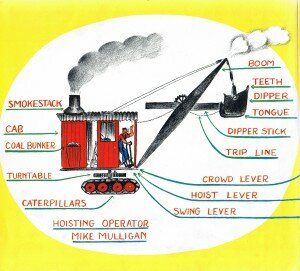
- NOTE: I Don’t See An Oiler In This Diagram
Lew Rockwell had a great post this morning (with video goodness!) about “Little Three” union officials slacking off and engaging in personal “business” (shopping, beer-buying) while on the clock. I wrote and related this story to Lew;
Hi Lew,
It is amazing to see a news organization, particularly one in a “union town” covering this story, since such abuses are longstanding and widespread. But there is nothing unique about what the two union reps in the story are accused of.
In 1993 - 1994, I was the safety and health manager of a large construction project ($280M) at a major oil refinery. Being a union plant, of course all of the contractors on the project were forced to hire union “labor” to do all tasks, including some that in a free market would not be done.
Before any work could commence, the contractors on the project had to sign a “project labor agreement”, or PLA, which set forth staffing requirements, work rules, and union jurisdiction. The number of unions involved in the endeavor was mind-boggling. We had carpenters, cement finishers, dockbuilders, electricians, laborers, millwrights, pipefitters, plumbers, teamsters, operating engineers, and one or two others I am sure I am forgetting.
Because the refinery was under a state-imposed environmental compliance deadline for completion, the project ran 2 12-hour shifts per day, 7 days per week to try to meet the deadline. Such mandates and deadlines always present tremendous opportunities for graft. I’ll spare you the details, except at one point the civil contractor was paying a “pipefitter” to make sandwiches for sale to the project personnel, which at 300 - plus workers undoubtedly handsomely enhanced his own personal profit.
Some of the unions even had subgroups, such as one class of operating engineers that ran pumps and generators up to a certain size, others that operated smaller loaders and excavators, another class of operators that ran larger excavators, and finally the “top” class of operating engineers, the crane operators.
The operating engineers’ contract at the time required that all equipment over a certain (arbitrary, low) horsepower be staffed by an operating engineer and an oiler, whether the maintenance regime for the equipment required continuous hand-oiling or not. I will leave it to you to ponder whether modern machinery made in the last 50 years would have such an intense need for maintenance.
Because this requirement undoubtedly caused many objections, an alternate “compliance” method was for the contractor to pay the operating engineer an extra hour for “grease time” (how apt), ostensibly to compensate the operating engineer for coming in an hour early to maintain and prepare his equipment for the start of the shift.
Except, remember, the project operated on 2 12-hour shifts, 7 days per week, which meant that during “grease time” the equipment was still being used by the operator on the previous shift. So we in essence have two operating engineers being paid to work 13 hours per day each, for a total of 26 hours of labor pay per qualifying machine per day.
It gets better. In the construction trades, the union representative is paid a little more than the highest-paid worker on the project. Because of the size of the crew, the project labor agreement mandated that the operating engineers have two project-paid union representatives, a “shop steward”, and a “master mechanic”, who were each paid “grease time’ also.
I’m not entirely sure what the duties of a “shop steward” are, but since the project already had 3 or 4 actual full-time mechanics, the “master mechanic” had few if any remaining visible duties. If you were lucky, you could get hold of him over the project radio system 3 to 4 hours per day at best. Allegedly one would have had better luck looking for him on the golf course most days, weather permitting. Yet because his position was mandated by the PLA, he was being paid 26 hours per day, 7 days per week.
After about 6-8 months of this, it became so embarrassing that the union itself actually put a stop to it, assigning a second-shift “master mechanic”, an extremely able, competent, and hard-working operating engineer who performed all of his union “duties” and operated equipment as well. But this was only one small instance of union abuse on the project.
Somewhere in this sorry tale I should mention that the construction ‘managers’ for the project were Kellogg, Brown, and Root (nee Brown and Root Braun), a particularly ill-named group of losers and no-accounts who actually impeded safety and progress on the project during their tenure.
Please use my alias if you print this.
UPDATE: This was funny.







The Next Bubble - Government Bonds
Which One Goes Next?
There seem to be a couple of likely candidates for the next bubble to pop, among them commercial real estate, with its heavy dependence on (collapsing) retail sales, and government bonds, which are are intimately tied to (ballooning) government infrastructure spending.
The people I have talked to about commercial real estate (owners / investors) seem split on whether / when the commercial realty bubble will pop, or whether it will be a slow outgas followed by gradual recovery.
In contrast, no one that I have heard or conversed with is optimistic about government bonds. Talking to a municipal bond trader the other day, I remarked ” the infrastructure spending in the proposed stimulus has got to be good news for your business, right?” He replied to the effect that no, most people in the bond business are very concerned that there is in actuality a growing bubble in government debt, which the stimulus bill has every chance of making much worse.
So, how do you short government bonds again?
(Image from philadelphia reflections, a monetarist’s blog, unfortunately)